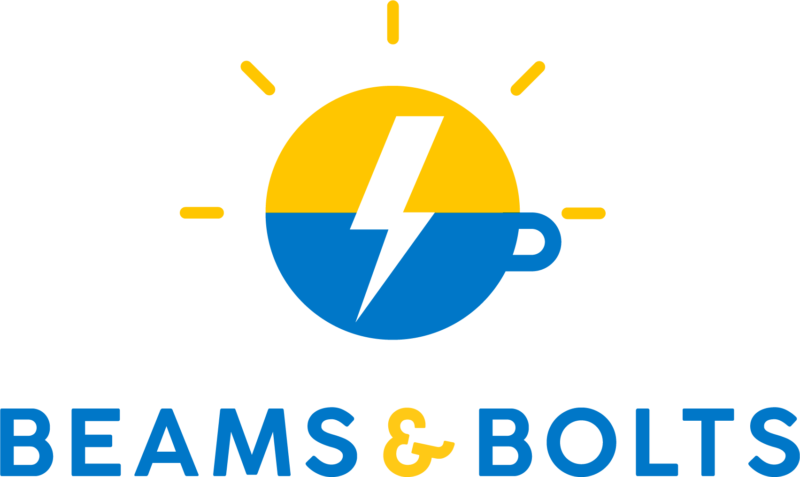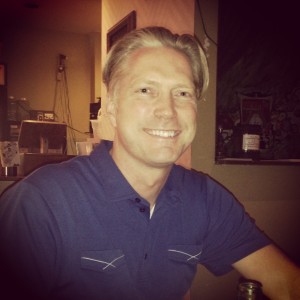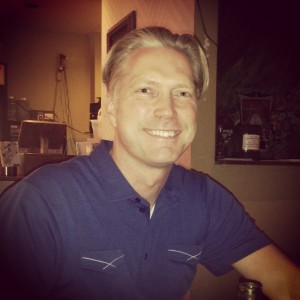The Cup: Coffee with a pump of peppermint syrup for me (because I was feeling a bit fancy) and black coffee and Topo Chico for Henrik. Though not together of course. Well, actually, come to think of it, I did see a recipe for coffee soda mixing Topo Chico with iced coffee. Haven’t tried it, but I’d be willing to. Today, the beverages were consumed independently.
Background: Cup 67, Eric Simone made this connection for me. He and Henrik are not only friends, but their wives are co-owners of the très chic Austin fashion hot spot, Girl Next Door. You may also recall, Henrik was the friend who joined Eric in his Improv experiment to overcome his fear of failure.
We’ll learn what Henrik really thinks of Improv, hear how he got from Sweden to the US and what he learned from the dot-com blow out. Before we get to all that, let’s cover some:
Common Grounds
- What is your guilty pleasure? Wine, candy and chips.
- What is the last thing you fixed? I am so not a fixer. I put up Halloween decorations, does that count? {I guess we’ll let that slide.}
- How did you make your first buck? Working in a coat hanger factory during the summer.
 What is a food you can’t live without? Candy. Specifically, Swedish candy. Sweden has great chocolate, and there are these incredible gummy candies – Swedish cars. {I ask him if Ikea used to sell them and he tells me they did. I know these candies. In a moment of weakness, I once bought a bag while standing in the checkout line. Because let’s face it, if you’ve survived a trip to Ikea and made it to the checkout, you deserve a reward. First reaction is, “Hmm, these are odd.” Followed immediately by, “Damn, these are the finest candies I’ve ever eaten! Did I really just buy one bag?” And then, for a moment, you consider going back into the great Swedish shopping abyss – making your way through the twists and turns, risking banged up ankles from mindless shopping cart pushers, simply to get another bag. Or 12. You resist the urge, and then are consumed with regret for the rest of time because Ikea no longer sells the Gummies of the Gods.}
What is a food you can’t live without? Candy. Specifically, Swedish candy. Sweden has great chocolate, and there are these incredible gummy candies – Swedish cars. {I ask him if Ikea used to sell them and he tells me they did. I know these candies. In a moment of weakness, I once bought a bag while standing in the checkout line. Because let’s face it, if you’ve survived a trip to Ikea and made it to the checkout, you deserve a reward. First reaction is, “Hmm, these are odd.” Followed immediately by, “Damn, these are the finest candies I’ve ever eaten! Did I really just buy one bag?” And then, for a moment, you consider going back into the great Swedish shopping abyss – making your way through the twists and turns, risking banged up ankles from mindless shopping cart pushers, simply to get another bag. Or 12. You resist the urge, and then are consumed with regret for the rest of time because Ikea no longer sells the Gummies of the Gods.}- What is the best gift you ever got? My mom, who is a pacifist and big into Amnesty International, never let me have war toys. But one year I got a toy pistol, and that was very memorable. I’m not big on things. The best gifts I’ve gotten are my health, my wife, my kids and my parents. That’s the stuff that really matters.
- What is something you’ll regret not doing if you don’t do it? Travel more. And going heli-skiing: a helicopter drops you off at the top of a mountain, and then you ski down untouched snow.
- What’s the best part about your job? Being an entrepreneur is extremely creative. You’re creating a business. A place people come and make a living – spending eight or more hours a day. That is my creative outlet. We’re creating stuff every day. I love the creative aspects of my job.
Henrik was born in Sweden to “non-entrepreneurial, frugal parents”, who placed a high value on hard work and education. He tells me he was very lucky to have had the upbringing he had, and credits it for making him the man he is today. In fact, when I ask about the most influential person in his life, Henrik talks about both of his parents, but recounts a specific story involving his dad.
The family was into cross-country skiing – a love Henrik’s dad passed along to his children. When downhill skiing became popular, Henrik went to his father and asked for a pair of downhill skis. Henrik’s dad said to him, “Well son, it’s pretty simple really. Get a job, save your money and buy some skis.” Not the answer Henrik was hoping for. He followed the advice though, and then following year, when he’d outgrown the skis he’d earned the previous season, he again approached his father, this time requesting an upgrade. His dad responded, “Well son, it’s pretty simple really. Get a job, save your money and buy some skis.”
“I thought he was a cheap bastard!”, Henrik says, “But he taught me a valuable lesson. If you want something, you’ve got to work for it.” This lesson has stayed with Henrik and has shaped his own business and life philosophies.
After college, Henrik realized that although he excelled at technology, what appealed to him most was the impact technology could have on people. He applied and interviewed for a consulting job with Anderson Consulting (now Accenture). It was the perfect fit. He could use his tech know-how, but in a way that allowed him to impact how people used it to achieve desired results. He’d get out the dungeon, where programmers worked heads down for hours on end, and into the world of people.
Henrik was so excited. Then he got the call. He didn’t get the job.
Henrik decided to learn from the experience and figure out why he was passed up. “Was it my long hair?”, he wondered. Turned out the ponytail was, in fact, to blame. He talked his way into another round of interviews, and not even a nasty stomach bug would prevent him from getting the job offer he so badly wanted. This time, he got the job. Bye, bye ponytail, hello cuff links.
He spent a couple of years in Stockholm before getting an opportunity to transfer to the Dallas office. Wow! Dallas is a bit of a culture shock coming from anywhere. I wondered what Henrik thought of the big hair, big hats, big trucks – lots of bling. He loved it! Especially once he met his own Dallas beauty, Koshla.
Henrik looks back on the experience of really working to get the job with Anderson and realizes it is what got him to the US, and allowed him to meet the love of his life and create the life of his dreams. He says it was a defining moment in his life.
Henrik and Koshla ended up moving to San Francisco, where Henrik eventually quit his job to start his first company. He and his co-founder, both first time entrepreneurs, were able to raise $35 million to build Creditland.com, which offered a service similar to Lending Tree. When it was time for another round of funding, the dot-com bubble had already been pricked, and the steady stream of flowing cash immediately dried up.
Henrik was forced to fire 100 people, and eventually close the doors to the company he’d poured his heart into. He says, “I learned a lot from the experience.”
Fortunately, while the business was still booming, Henrik and Koshla had gotten married and enjoyed a wedding that sounds like the stuff of fairy tales – including opera singers. In 2001, the couple decided to head back to Texas for a fresh start. When an Austin company looking for Henrik’s talents came knocking, they packed up and moved to Austin.
Henrik spent a few years turning that company around, but as he says, “Once you get start-up in your blood, it’s hard to do anything else.” It was time for another business.
In 2005, Henrik and his co-founder, Jason Black, decided to disrupt the promotional product space, and launched Boundless Network – whose missions is, “To improve how organizations buy and manage branded merchandise.” Eight years in, it looks like they’re managed to do so, quite successfully. The company has some of the most successful investors backing it, including Austin Ventures and Silverton Investors. They are looking at $60 million in revenue this year and employ just under 60 people. Not bad for a fragmented industry where no one had more than 2% market share.
One of their biggest customer segments is non-profits, where promotional products tend to be a huge part of their fundraising efforts. If you’ve ever done a walk, run or bike ride for a cause, you probably have a drawer full of event t-shirts and a cupboard full of water bottles. Or, did you ever do Jump Rope For Heart when you were a kid? I did. And I can still recall how exciting it was to earn my swag – a frisbee, a jump rope and a Walkman.
Henrik tells me Boundless Network has created a social platform, similar to Pinterest, where clients can look at contextual reviews of the products they are considering buying, and get ideas for how they were used by other organizations and what the results were. For example, a company might say, “We bought this pen, paired it with this notebook and this marketing message, and it yielded this result.”
In addition to helping clients buy smarter and create campaigns with predictable results, Boundless Network is helping organizations save money. A recent success story comes from Canada, where the smarter bulk buying solutions saved an organization $500,000 a year. Dang, half a million bucks – that will buy you a whole lot of poutine and Tim Horton’s. Or if you’re the Canadian Cancer Foundation, it means you can help more people get the care and support they need. Wow! What an impact!
Speaking of impact, I ask Henrik about a book that had a significant impact on his life. For him, it’s an oldie, but a goodie – The Seven Habits of Highly Effective People, by the acclaimed personal development juggernaut, Stephen Covey. Henrik tells me the book introduced a powerful concept to him. Between action and reaction, there is a moment of decision. You have the power to decide how you’re going to react to everything in life. He says, “That knowledge gave me incredible power. It changed how I behaved and interacted. Most people just go through life and react to things. The choice is yours, which means there are no excuses. If you are miserable, that’s your choice.”
While we’re on the subject of habits, I ask Henrik if he had a routine or habit that he feels contributes to his overall success. He does. He gets up early and plans his day. After he gets a cup of coffee, he resists the temptation to look at email, and instead takes a few moments to just sit and think. He also has a set of affirmations that he tries to go over. The most recent have come from reading The Greatest Salesman in the World, by Og Mandino. One affirmation Henrik focuses on is “I will greet this day with love in my heart.” Show love and compassion to the world and you shall find it returned.
A fan of personal development, Henrik says when Eric suggested they try Improv, he was willing to give it a try. For Eric, it was all about learning to get comfortable with failure. For Henrik, he wanted to be funnier.
“I realized that I wasn’t as funny in English as I was in Swedish and thought it might a problem with timing,” Henrik admits. “When someone says something, you can’t come back 10 seconds later and say, ‘Remember what you said a few moments ago? Well, here’s something funny about that.’ In Improv, you have no time to prepare and I hoped it would help me be funnier.”
Henrik said in the six months he spent taking classes, he absolutely made progress. He said, “Improv is liberating. You just have to react. It’s about accepting what’s given to you and then going with the flow. And there is no way to fail. It’s freedom.”
When I ask Henrik about something he believed to be true for a long time, but now knows differently, he introduces me to a new concept – lagom. Lagom is a Swedish word that has no English equivalent. As such, it is a little hard to describe. Henrik offers, “average, balanced, just right” in an attempt to get me there. He believes lagom is the source of that Swedish happiness that often makes the news. He wanted to find a way to bring the concept to the US. He started two blogs and had plans to write a book to spread the word. But then he realized that the reason it was so hard to explain is that the concept is rooted in Swedish society. It is unique to decades of culture and equality that exists in Sweden. Without the same culture, lagom just can’t exist.
Given 30 seconds to make a speech to the world, Henrik would have this to say: “Be kind to others. Treat others like you want to be treated. Someone once said about my relationship with my wife, ‘It is so extraordinary because you are so kind to each other.’ Nobody expressed it quite like that before. I think there’s just not enough kindness. If everyone was kind to each other, I think we could solve a lot of problems. I think the other thing is that we need to be kind to ourselves. When people are not kind to themselves, it creates more unhappiness in their actions to the rest of the world. If we could learn to appreciate ourselves for who we are, we’d be a lot happier and kinder. And, you should try Swedish candy.”
Henrik’s story is chock full of important lessons and reminders for each of us as we live our lives – all working toward the same goal – happiness.
Work hard and you will appreciate things much more. A successful business shouldn’t be measured solely by what you find on a P&L. What difference is it making? Who’s lives are better because it exists? These matter equally, if not more than, the dollar figure at the bottom of a ledger. Life, like Improv, is about taking what’s given to you and then going with the flow, knowing that you own that moment between action and reaction and the decision is yours alone. Miserable or blissful – it really is up to you. Lagom may not be in the English vocabulary, but in the moment of decision, if we realize that everything is “just right” then we can have it in our minds and in our hearts. Finally, kindness comes from within. Start there and suddenly you’ll find that kindness is all around you.
 PS – If you’ve taken nothing else away from this blog post, please take this one action immediately. Call Ikea and demand they bring back the gummy cars!
PS – If you’ve taken nothing else away from this blog post, please take this one action immediately. Call Ikea and demand they bring back the gummy cars!



1 thought on “Cup 69: Henrik Johansson – Swedish native, left-brain creative and chronic entrepreneur.”